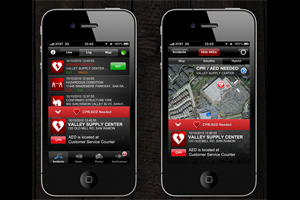iPhone AED App Could Help EMS
By Ann-Marie Lindstrom, originally posted on jems.com Feb. 10, 2011.

A California fire department’s iPhone app might help improve survival rates for sudden cardiac arrest. Photo Courtesy San Ramon Valley Fire Department
It won’t be a case of blind luck. The PSAP will call the civilians’ iPhones to announce a collapse. If the bystander opens their phone, it will show a map with pushpin graphics showing their location, the patient’s location and the location of the automated electronic defibrillator (AED) closest to the patient. This will all happen at about the same time you get the call. Because the bystanders will be within a 500-foot radius of the patient, they will likely arrive before you do. If the patient is lucky, the bystanders will have kept the patient alive long enough for you to begin your efforts on arrival.
This isn’t science fiction. The system for this is up and running within the San Ramon (Calif.) Valley Fire District’s coverage area. The iPhone app was unveiled on Jan. 25 after 18 months of development and six months of trials. During the trials, 27,000 iPhone users used a limited version of the app. Paramedic, information technology specialist and project manager Lucas Hirst says, “One of the things we had to make sure of was that a high numbers of push notifications wouldn’t crash our server.” There were 600,000 push notifications during the trials. Plus, the development team had to wait for new versions of the iPhone—versions 4.0 and 4.2, which allowed location apps to run in the background without draining the iPhones’ batteries.
David Koenig, a self-proclaimed social media evangelist and co-founder of PIO Social Media Training, isn’t surprised to see this app. “We always figured we’d see something like this. It is a great use of technology. And it is huge that they are sharing it with other agencies,” he says.
Interestingly, the project is the result of lunch. SRVFD Fire Chief Richard Price was eating in a local restaurant with other members of the department, including Hirst, unaware of a collapse in the business next door until fire trucks started arriving. Price had an AED in his car. Paramedics were sitting around the table, totally oblivious to the medical emergency just yards away from them. The discussion that followed ended with the decision to come up with something that would avoid this scenario from repeating itself. That patient survived; he beat the odds. The national average for sudden cardiac arrest survival range is between 5–8%.
The goal of the iPhone app is to get CPR-trained civilians to the patient’s side as quickly as possible.
Local App, National Impact
The implications for the app are enormous. San Ramon, which has a population of about 200,000, started the public rollout with 27,000 users. During the first week after the unveiling, they enrolled about 600 people a day.
National EMS Management Association President Skip Kirkwood says, “Citizen CPR has always been a crapshoot. They have to be in the right place at precisely the right time.”
Not anymore; they just have to be nearby. Price compares the app to someone asking, “Is there a doctor in the house?”
During the first week, SRVFD has seen an increase in requests for CPR training and information about AEDs. Although businesses and organizations are supposed to register their AEDs with the department, some have contacted the department to tell them about devices that don’t show up on the map.
The publicity surrounding the app has dramatically raised public awareness in the area. As more people enroll and tell their co-workers, friends and families, more will probably want to be involved. Chief Price describes installing the app as a way to volunteer for community service.
Greg Friese, director of education for CentreLearn, an online education provider, sees a fundamental shift from previous iPhone apps, including the EPIpen app that supplied reference material. “This is locally focused public involvement. Part of a multi-pronged approach to get people involved in bystander CPR and AEDs,” he says.
How it Works
When citizens download the free app, they must push a button that indicates they’re CPR-trained and ready to respond when they get a notification to be entered into the system. When an incident occurs and the dispatch server determines whether anyone is near the patient, those phones with the app will alert the owners. The owners can immediately see a window reporting the incident. Each can then can choose to open the phone for more details or ignore the call.
The app is currently tailored to SRVFD’s computer-aided dispatch system. The department continues work to modify the app for other departments and agencies that would like to adopt the system.
The technology exists. Now it’s time to use it. It’s bound to save lives—and the more lives, the more widespread it is.
To learn more, visit www.firedepartment.mobi. At the bottom of the page is a link to “Agency Interest” with a form to fill out for information about obtaining the app.
Posted with permission of Elsevier Public Safety.

